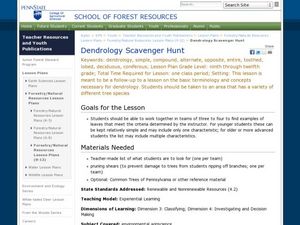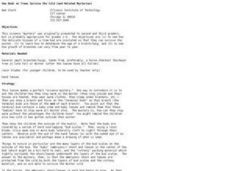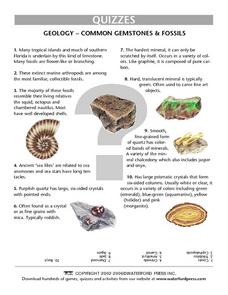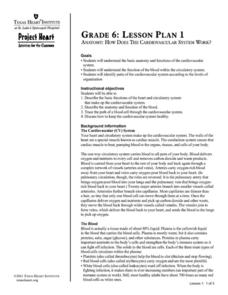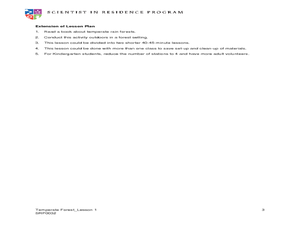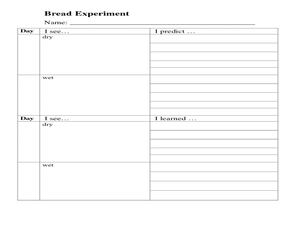Channel Islands Film
Human Impact on the Food Web of Santa Cruz Island
What happens when a non-native species is introduced onto an island? Santa Cruz Island, part of the Channel Island chain located off the coast of southern California, provides the perfect laboratory for young environmental scientists to...
Rainforest Alliance
Trees and Carbon
You'll find everything but the kitchen sink here ... or just a carbon sink. In the activity, pairs or groups of middle school learners go outside and measure a tree's circumference and height to estimate its carbon storage potential and...
Curated OER
Honey Bees!
Students research and complete two assignments about honeybees. Students draw and color a picture of a flower with a honeybee inside of it. Students write a letter to the executives at Ridit Pest Control persuading them to stop the...
Curated OER
Tree Lesson
Students compare and contrast characteristics of conifer and hardwood trees. After collecting samples of branches around the school, they classify the branch as hardwood or conifer. Groups of students identify given twigs. They go...
Curated OER
Dendrology Scavenger Hunt
Students examine leaves that are assigned to them. In this earth science lesson plan students work in groups and find examples of leaves that the instructor asks for.
Curated OER
Dem Bones
Students engage in an activity in order to review the skeletal system. They play a game composed of two teams to be played in an open area. Students pick out bones from a bag and place them in the correct space for the skeleton.
Curated OER
Science: Down Home Dinosaurs
young scholars participate in hands-on activities to discover the different types of fossils. Using teacher-provided materials, they make models of cast and trace fossils. After writing essays describing how traces are formed, students...
Curated OER
The Four Groups of Biologically Important Compounds
This is not they typical set of teacher instructions. It is an organized chart of the important organic compounds. For each, the involved elements, the name of the building block monomers, the names of polymers, extra information, and a...
Curated OER
Fetal Pig: Circulatory System
Step-by-step instructions for fetal pig dissection and viewing of the circulatory system is given in this exercise. Your young biologists match the names to the organs or label a diagram of the pig circulatory system. This resource...
Curated OER
Presidential Database
Ninth graders research the Presidents of the United States. They develop generalizations about the nature of the Executive Branch using the researched information. Students complete a Query worksheet about the Presidents.
Curated OER
How Buds on Trees Survive the Cold (and Related Mysteries)
Students solve a science mystery. In this biology lesson plan, students see how the delicate tissues of a tree bud are insulated so that they can survive the winter and learn how to determine the age of a branches and twigs.
Curated OER
Dinosaur Reading Comprehension #2
In this science and reading worksheet, learners read 4 short paragraphs, each describing a particular dinosaur. Students answer 3 questions after each paragraph, then look up and define 3 words.
Curated OER
A Peek at the Past: Gradualism vs. Punctuated Equilibria
Students consider two sets of simulated fossils (caminalcules) that are provided as cutouts. They arrange them on two time scales. One set produces a visual example of gradualism, the other shows punctuated equilibria.
Curated OER
Common Gemstones and Fossils
In this science worksheet, 4th graders respond to questions pertaining to gems and fossils. Students answer ten questions which give clues and visual aids to assist in answering.
Curated OER
Electrical Circuits
Students compare series and parallel circuits. For this electricity and circuits lesson, students roleplay as a "wire" passing an energy ball to demonstrate how a series circuit works and how the circuit can be broken. Students construct...
Texas Heart Institute
Anatomy: How Does the Cardiovascular System Work?
How can the circulatory system compare to a city map? Pupils distinguish the "roadways" and "vehicles" of the cardiovascular system, compare the anatomy and function of veins and arteries, and review different types of blood cells with...
Curated OER
Introduction to Adaptation
Tenth graders observe collections of specimens and discuss their answers to provided questions. They explore common ancestry, homology, analogy, adaptive radiation, and evolution, while formulating creative answers based on their...
Curated OER
Design a Reef!
Here is an ambitious, but highly valuable undertaking: set up a miniature coral reef in your classroom. Young marine scientists research coral reef ecosystems and ensure all vital factors are included in their functioning model. The...
Curated OER
Probability
Here is a classic activity used to introduce your class to the concept of probability and data collection. They will roll one die 30 times, then record and discuss the results. Great introduction, but too shallow to be considered a...
Curated OER
Making a Human Tree
Students explore botany by defining the anatomy of a tree. In this environmental exploration lesson, students research plant vocabulary terms and discuss the uses of each word. Students create a "human" tree by role-playing as one of the...
Curated OER
Sun Prints
Students discuss energy and where they can find it. They will then discuss the sun and how it functions as an energy source. Next, students get a piece of black paper and some coins. They go outside and make a design with the coins on...
Curated OER
Structures and Behaviors of Planarians
Students investigate planaria of the phylum platyhelminthes. They use DigiScope technology to observe and describe the structure and movements of planarians.
Curated OER
Exploring Forest Objects
Students explore the forest. In this ecosystems lesson, students rotate through sensory activity centers, brainstorm, and read about temperate forests.
Curated OER
Forest Decomposition
Students explore decomposition. Students define and describe components of the decomposition process. Students make a composter in a terrarium. Students record observations and changes weekly, drawing conclusions about the results...






